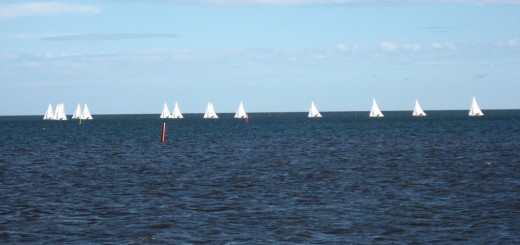Research Summary: Distribution, Seasonality And Putative Origin Of Non-Native Red Alga Bangia Atropurpurea In The Laurentian Great Lakes
0The red alga, Bangia atropurpurea, was initially described by Roth in 1805 from the Weser River in Germany and since then has been reported from rivers in Europe and Asia. In 1964, the first observation of this species in North American freshwaters was in Buffalo Harbor, Lake Erie (Lin & Blum, 1977) and from the mid-to-late 1970s it spread throughout the lower Laurentian Great Lakes. Initially, it was hypothesized to be conspecific with the marine species, Bangia fuscopurpurea, especially since the latter can acclimate to freshwater (Geesink, 1973); thus, it was proposed that this species invaded the Great Lakes from the Atlantic coast through the St. Lawrence River. In 1998, Müller et al. conducted the first molecular analysis of freshwater and marine collections of Bangia. They showed the freshwater B. atropurpurea in the Great Lakes was not an invader from the marine environment. Instead, it was likely transported to the Great Lakes via ballast water or attached to ship hulls from Europe.
The present study was initiated to examine more recent distributions of this species in the Great Lakes, examine the seasonal variation of population and to conduct new DNA sequence analyses to determine the origin of this alga in the Great Lakes.

Bangia atropurpurea. (Credit: Robert Sheath)
Methods
In fall 1995 and spring and fall 2002, we completed shoreline surveys sampling 87 and 104 sites, respectively, around the Great Lakes to determine the presence or absence of this species. Collections were examined for morphological and reproductive characteristics and analyzed for DNA sequences (cox2–3 gene spacer, the nuclear internal transcribed spacers, ITS 1 and 2, and the 5.8S rRNA gene). To examine its seasonality, sampling occurred once a month from December 2001 to November 2002 in Burlington, Ontario, Canada. Algal samples were collected from ten sites along the shoreline 10 m apart and environmental parameters were measured. Filaments of B. atropurpurea were measured for various morphological characteristics including filament width and diameter and asexual spores.

Filaments of Bangia atropurpurea. (Credit: Kirsten Müller)
Results
Bangia atropurpurea has spread based on the 1995 and 2002 surveys compared to that from the 1980s (Sheath, 1987). There were newly identified populations in Lakes Huron, Michigan, Georgian Bay and the first observation in the St. Lawrence River (in 1995). Morphological analyses showed that Great Lakes populations from individual lakes or neighboring populations did not group together in cluster analyses. On the other hand, correlation analysis revealed significant relationships between the presence or absence of this alga with pH and specific conductance. In fact, locations with stable populations had a mean pH 8.2 and conductance 353 μS·cm−1. Seasonal variation in morphology showed maximum filament length occurred in April, with the greatest diameter and asexual spore production observed in May. Significant correlations were also noted for many morphological characteristics with water temperature, population height on the shoreline relative to the waterline and total phosphorus. The molecular analyses showed B. atropurpurea from the Great Lakes had an identical sequence to collections of freshwater Bangia from Europe.

Bangia atropurpurea. (Credit: Kirsten Müller)
Conclusions
This study demonstrated that the distribution (14 new populations) of B. atropurpurea in the Laurentian Great Lakes has increased since Sheath (1987). In addition, it was reported for the first time in the southern-most point of Georgian Bay (Collingwood, Ontario) and in the St. Lawrence River (Prescott, Ontario). Bangia has previously been shown to prefer colder water temperatures (Garwood, 1982; Sheath, 1987) and this result was corroborated with water temperature significantly correlated to filament length and number of cells. Filaments were largest when water temperatures were between 5 and 15 °C. Analyses of the internal transcribed spacer (ITS) sequences and the cox2–3 spacer of the Great Lakes Bangia populations were identical to those from Europe, suggesting a recent invasion from a European source.
Full study published in the Journal of Great Lakes Research, March 2014.
Selected References
- Garwood, P.E., 1982. Ecological interactions among Bangia, Cladophora, and Ulothrix along the Lake Erie shoreline. J. Great Lakes Res. 8, 54–60.
- Geesink, R., 1973. Experimental investigations on marine and freshwater Bangia (Rhodophyta) from the Netherlands. J. Exp. Mar. Biol. 11, 239–247.
- Lin, C.K., Blum, J.L., 1977. Recent invasion of a red alga (Bangia atropurpurea) in Lake Michigan. J. Fish. Res. Board Can. 34, 2413–2416.
- Müller, K.M., Sheath, R.G., Vis, M.L., Crease, T.J., Cole, K.M., 1998. Biogeography and systematics of Bangia (Bangiales, Rhodophyta) based on Rubisco spacer, rbcL gene and 18S rRNA gene sequences and morphometric analyses. 1. North America. Phycologia 37, 195–207.
- Sheath, R.G., 1987. Invasions into the Laurentian Great Lakes by marine algae. Arch. Hydrobiol. Ergeb. Limnol. 25, 165–186.
Featured image: Great Lakes region as seen from space. (Credit: NASA)













